As Lombardo prepares State of the State, a look at the speech’s role in Nevada history
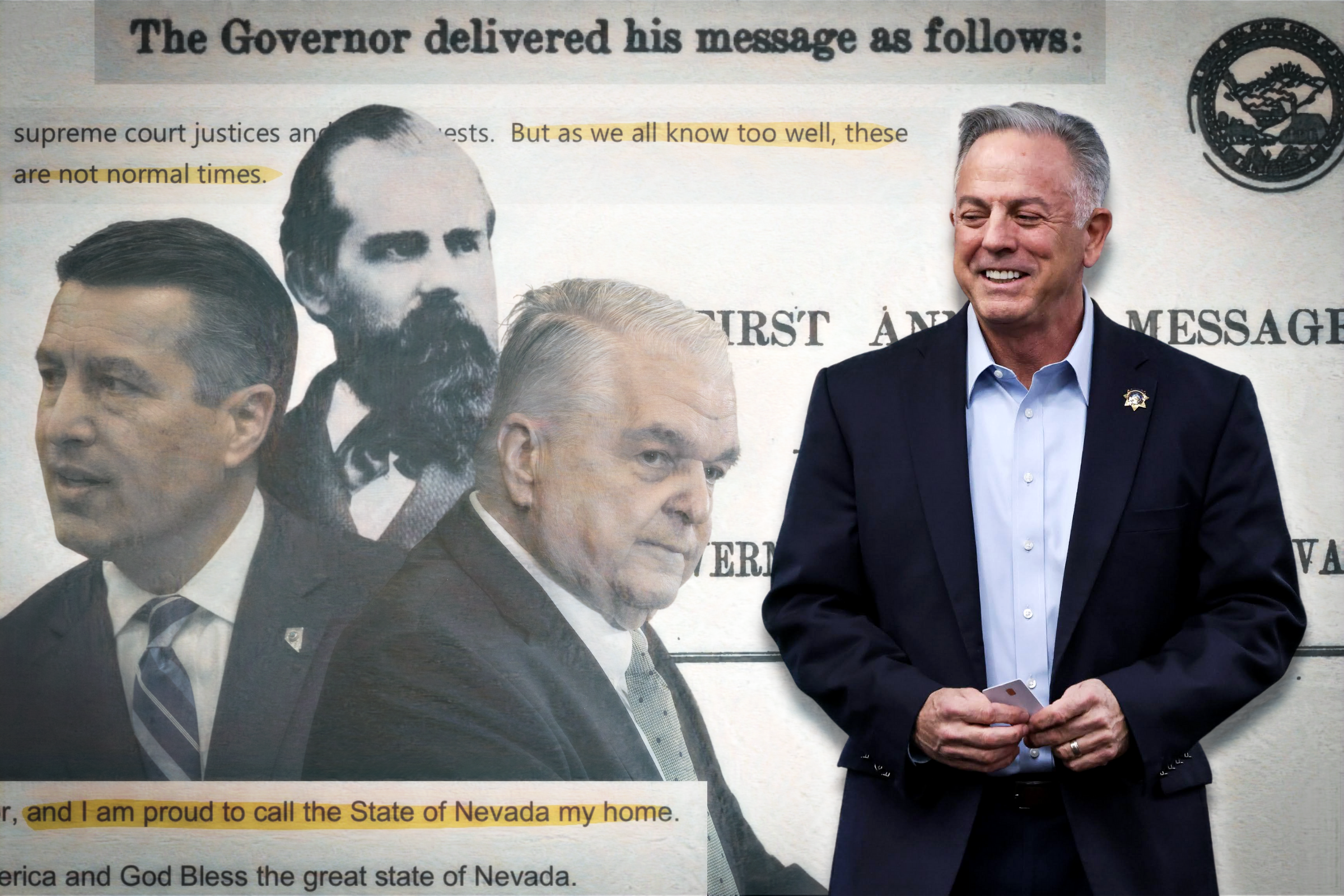
It’s known as the State of the State — a biennial address the governor delivers to the Legislature to highlight policy priorities and discuss the condition of Nevada.
On Monday evening, Republican Gov. Joe Lombardo will make his first such address to the Legislature in the Assembly Chamber at the Legislative Building in Carson City. The speech will provide Lombardo with an opportunity to lay out his administration's legislative agenda and proposed budget, though he already set some broad policy priorities during his gubernatorial campaign, including an expansion of school choice, economic diversification and repeal of “soft-on-crime” legislation.
Referred to as the “governor’s message” in the Nevada Constitution, and required alongside every regular legislative session, the address has provided the state’s chief executives with a chance to outline their vision for the state since Nevada’s first elected governor, H.G. Blasdel, delivered his first such speech in December 1864.
Former Republican Gov. Bob List, who served from 1979-1983, described the speech in an interview as “an opportunity to lay your groundwork with the Legislature,” adding, though, that “it's bigger than that.”
“It's telling the people the same thing — the people who campaigned for you and contributed to you and worked hard to get you elected or are going to be looking for the things that were promised during the campaign,” he said. “Usually it goes beyond just legislative plans. It goes into the bigger realm of what's your greatest concern about this state and what's happening.”
The message also coincides closely with the release of the governor’s recommended two-year budget — which is divided into different portions and must be approved by a majority of lawmakers in both houses by the end of the 120-day legislative session, which this year falls on June 5.
What do governors typically talk about?
Per the Nevada Constitution, the governor’s message shall be used to communicate “the condition of the State and recommend such measures as he may deem expedient.”
Since Blasdel’s first address in 1864, the messages have revolved around similar key issues, including the economy, public safety and education.
In his address, parts of Blasdel’s speech covered controversial subjects that are still hotly debated in the Silver State nearly 160 years later — including the taxation of mining proceeds, safeguarding elections and the “purity of the ballot box,” and closely aligned interests between the state and neighboring California.
Democratic Gov. Steve Sisolak, in his first address to the Legislature in 2019, promised salary increases for teachers, an increase to the minimum wage and the creation of the Cannabis Compliance Board.
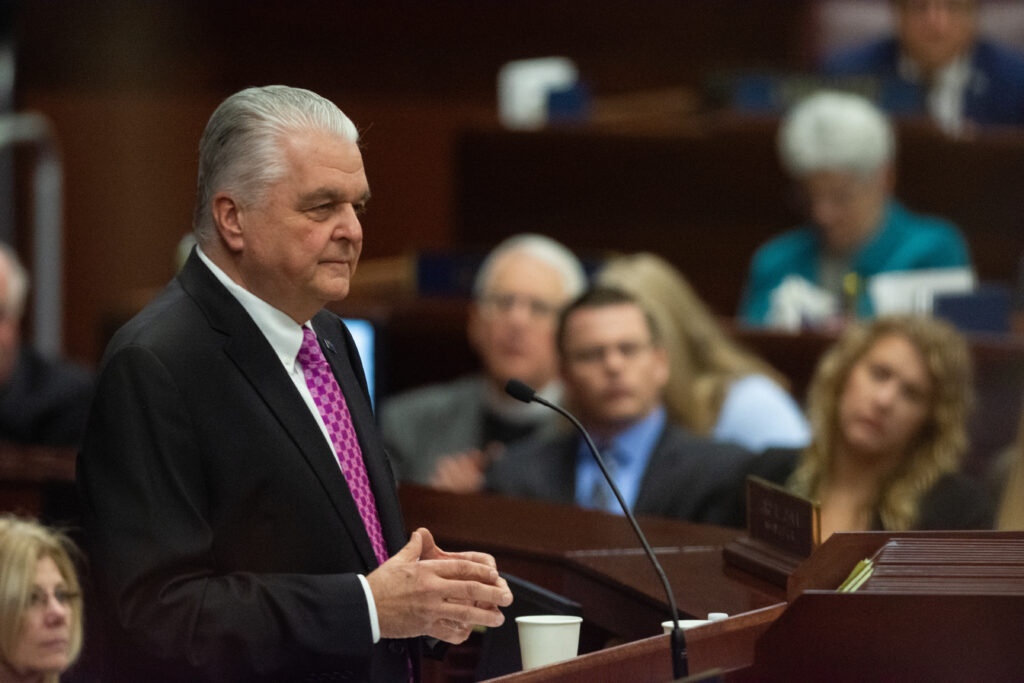
Governors also have used the speeches to draw attention to national issues relevant to the state. In 1913, Republican Gov. Tasker Oddie recommended approval of a constitutional amendment to grant women the right to vote, noting that women had the right to vote in “every Pacific Coast State except Nevada.”
Michael Green, a history professor at UNLV, noted that some governors have used the speech to introduce major policy ideas, including Democratic Gov. Grant Sawyer, who served from 1959-1967, calling for “significant changes to gaming regulation,” and Republican Gov. Kenny Guinn, who served from 1999-2007, proposing the establishment of the Millennium Scholarship for Nevada high school graduates.
Those proposals led to long-lasting policy changes for the state, such as the creation of the Nevada Gaming Commission under Sawyer.
But other ideas have proved less popular, such as Guinn’s proposal in 2003 for a slew of tax increases to raise nearly $1 billion in new revenue, which attracted an unsuccessful recall campaign against him and led to two legislative special sessions and a Nevada Supreme Court case.
“Governors do sometimes swing for the fences,” Green said. “Sometimes the ball goes over the fence, sometimes it ends up being a hit, and sometimes the governor gets to return to the dugout, unsuccessful.”
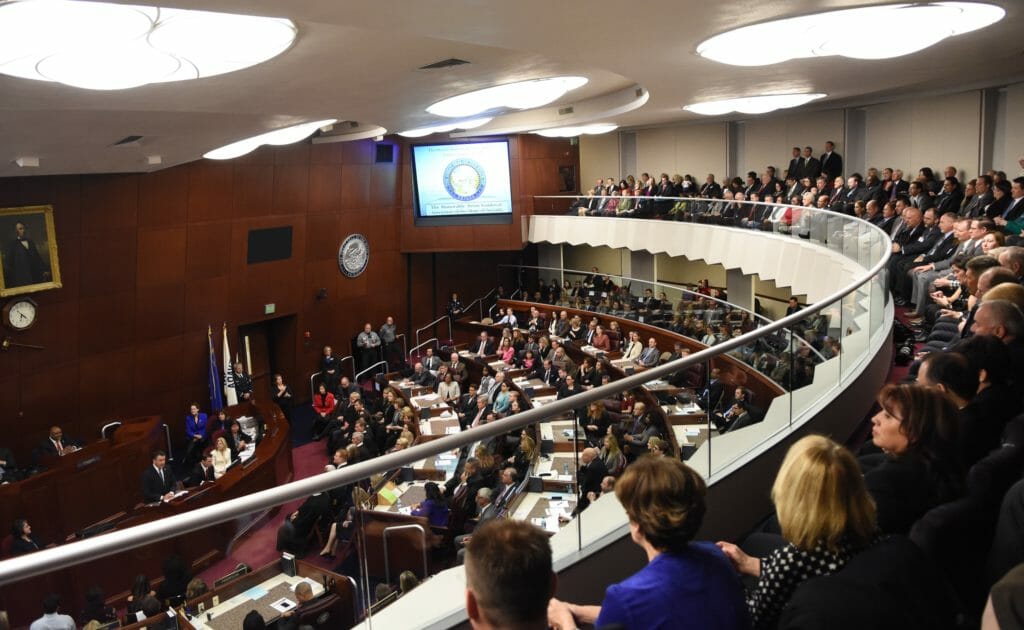
Republican governor, Democratic Legislature
When Nevada last had a Republican governor, Brian Sandoval delivered his final State of the State address in 2017 before a Legislature led by Democratic majorities in both chambers. Now, Lombardo will do the same.
List faced a similar situation in 1979 and 1981 as a Republican governor working with a Democrat-led Legislature. He described the speech as an opportunity to put aside those political divisions.
“This is a time when a governor tries to bring these people together and to persuade them that this is what our state needs,” he said.
As governors seek to appeal to members of the opposite party who may be crucial to passing a governor’s agenda, Green said they need to strike the right tone with lawmakers, pointing to Sawyer’s proposal in 1959 to create a “Commission on Human Relations.”
“[It] sounds a little bit now like he wants a new HR department, but he was referring to an equal rights or civil rights commission,” Green said. “But he also knew that ‘civil rights’ was, for some of the legislators he would deal with, a trigger word.”
Former Gov. Richard Bryan, a Democrat who served from 1983-1989, said he wanted to connect with legislators through his speech. Bryan found himself in an unusual position, however, having previously served in the Legislature.
“I was trying to bond again with my former legislative colleagues,” he said. “I remember saying something like, ‘I pledge my support, and I ask for yours’ type of thing.”
But the speech can also provide a closer look at what the key tension points might be for the session. For Lombardo, that could be education. He has been a vocal supporter of school choice, despite yearslong opposition to the concept from Nevada Democrats, who see some policies that implement the idea as a drain on limited dollars for traditional public schools.
Still, the governor wields significant power in setting the legislative agenda, Fred Lokken, a political science professor at Truckee Meadows Community College, explained. That comes both from the power to propose the initial budget — which is typically subject to tweaks from lawmakers, and not transformative changes — and have the final say on lawmakers’ bills.
“The governor can be fairly confident that his vetoes withstand,” he said. “The threat of veto will be used throughout the spring to sort of shift some of the Democratic thinking on spending priorities and spending amounts in the budget.”
A governor’s first State of the State
When Lombardo delivers his address on Monday, it will be the first of at least two State of the State speeches he will give as governor, unless he exits office early. Lokken said the first speech will be key for Lombardo to set the tone for his administration.
“The very first one is often the most important — especially when you're transitioning from a Democratic governor to a Republican governor — in setting that new tone,” he said.
Following a campaign that focused on only a few key issues, including education and public safety, the speech will provide Lombardo with an uninterrupted platform to communicate his other goals.
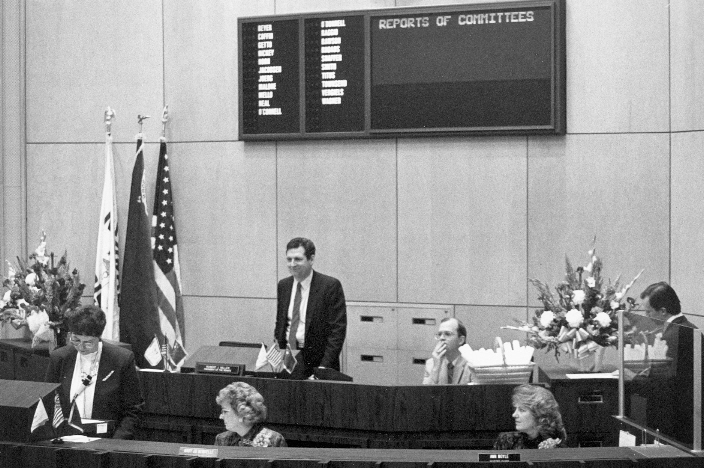
In some cases, the most important topics for the speech may be clear even when putting aside a governor’s agenda. For Bryan, his first State of the State was focused on the economy and state budget.
“In that ‘83 timeframe … the state was in dire financial straits, and so that was going to dominate much of the discussion,” he said. “We talked about some taxes that we wanted to increase, some taxes that I tried to get, a property tax increase. [I] was unsuccessful for that, but it was heavy-duty stuff.”
Despite the quick turnaround for a governor’s first State of the State — Lombardo’s takes place two and half months after Election Day and just three weeks after his inauguration — List said the first speech is not necessarily the most challenging because “you are probably the best informed you're ever going to be” after finishing a statewide campaign.
“You know the state like the back of your hand,” List said. “You've met with working men and women, you've met with dealers and you've met people that work in the mines. You've met the retail store people and transportation folks and airline pilots and all of the mayors and the councilmen [and] commissioners all over the state. You know what they're asking for and what it is they're hoping to see.”
Unlike List and Bryan, Lombardo will deliver his speech before the start of the session. Before 1999, when Nevada held its first legislative session capped at 120 days, governors would typically deliver their addresses during the first week of the session.
What to expect from Lombardo
After a narrow general election victory and an inaugural address that saw Lombardo call for unity among Nevadans, Lokken said he would be shocked to see a very partisan speech given Democratic control of the Legislature.
“It's hard to be heavy handed when you're in a divided government because this is the same group that you have to persuade to support some of your priorities that you promised in your campaign,” he said.
Green echoed that sentiment, saying that if, for example, Lombardo were to address the possibility of a recession and target Democrats on that subject, it could lead to severe policy consequences.
“I would expect him to say, if there's a recession, we're going to have to cut and hunker down and use all of those tightening-the-belt expressions,” Green said. “If he wants to say it's all the fault of the Democratic Party, I can imagine the Democratic Legislature saying, ‘Oh, well bye bye school choice.’ So that's part of the dance.”
Green also said a speech focused on policy may be new ground for Lombardo, whose previous leadership experience included eight years as sheriff of the Las Vegas Metropolitan Police Department.
Though there is spectacle surrounding the speech — major political and business figures will be present, and it is typically given just once every two years — Lokken said the speeches are not usually memorable.
“We tend to elect good practical politicians, but we don't tend to elect great communicators,” Lokken said. “So our governors have historically, in the modern era, been kind of awkward … Most of them, it's not in their wheelhouse, and so they're not memorable events.”
Having delivered three State of the State addresses in his term, List recalled spending a lot of time preparing.
“You really have to dig deep into your judgments about what's most important, what really drives your day-to-day work,” he said. “So it's something that you're privileged to give and you really have a responsibility to be dead honest about everything.”
How will Democratic leaders respond?
After a governor delivers the address, members of the opposite party traditionally have responded with a short speech of their own — usually delivered by a leading member of the party, such as the Senate majority leader.
In 2017, then-Democratic Senate Majority Leader Aaron Ford delivered a response to Sandoval’s address, during which Ford laid out Democrats’ policy priorities for the upcoming session, later described by the group as the “Nevada Blueprint.”
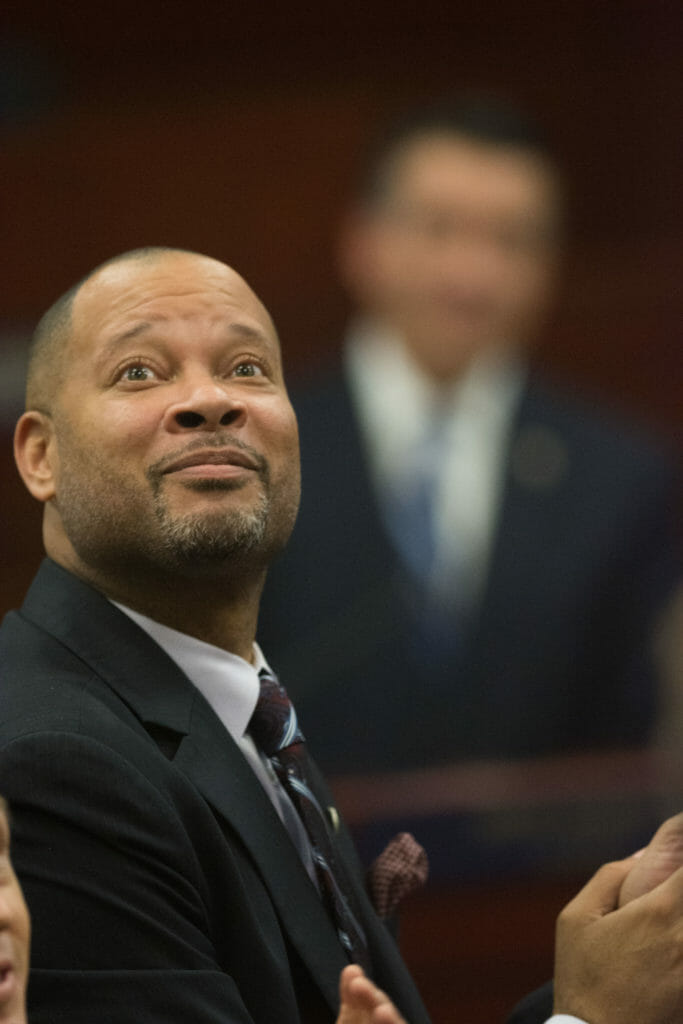
With Democrats in power, Green said they’ll have the opportunity to shut down policy ideas they oppose.
“I do think it's an opportunity for the opposition party … to say, ‘Here's what we want to accomplish,’ and they also get to say, ‘Oh, this proposal, [dead on arrival,]’” Green said. “It gives an indication of what the fighting might be about.”
But the opposing party’s response can also be used to highlight opportunities for compromise, Lokken said.
“I think that there can be easily a recognition in both of their speeches, that they have differences, but that they have faith in our political process with the Republican and Democratic leaders … working with the new team in the governor's office to help find where the common ground is,” he said.
This year, Senate Majority Leader Nicole Cannizzaro (D-Las Vegas) and Speaker-Elect Steve Yeager (D-Las Vegas) will hold a joint press conference Monday night after Lombardo’s speech concludes.
Off-year State of the State addresses are a rarity
Though Sisolak delivered a State of the State address last February with no legislative session in sight, it marked only the second time this century that a Nevada governor gave an address outside of the normal pre-session period.
The only other time saw Republican Gov. Jim Gibbons — another single-term governor — call for a special legislative session in 2010 as the Great Recession ravaged the state’s economy and created a significant budget shortfall.
Green pointed to one commonality between the two speeches — the two men were both up for re-election the year they delivered them.

During Sisolak’s 2022 address, which came less than two years after the start of the COVID-19 pandemic that decimated the Nevada economy, he outlined his plans for spending nearly $2 billion in federal pandemic relief money. They included $500 million for a sweeping affordable housing initiative and major investments in child care — measures that were approved by the Legislature’s interim money committee by year’s end.
Though the off-year address was panned by political opponents, who criticized Sisolak for using his executive office to advance his gubernatorial campaign, his office tied the speech to the pandemic recovery and massive influx of federal funds received by the state.
Prior to Gibbons, Democratic Gov. Bob Miller was the last to deliver an off-year address, using a 1990 speech to discuss the “war on drugs,” education and other key issues facing the state.
